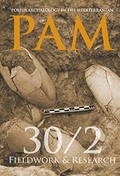The House of Aion in Nea Paphos: seat of an artistic synodos?
The House of Aion in Nea Paphos: seat of an artistic synodos?
Author(s): Elżbieta JastrzębowskaSubject(s): Archaeology, Cultural history, Visual Arts, Local History / Microhistory, Ancient World, History of Art
Published by: Wydawnictwa Uniwersytetu Warszawskiego
Keywords: triclinium; mosaics; paintings; Dionysus; Apollo; Muses; theater; associations;
Summary/Abstract: The article presents some archaeological observations based on recent publications and the author’s survey in situ of the so-called “House of Aion” at Nea Paphos in Cyprus. The archaeological context (coins and pottery) dates the last phase of this building to the 320s, its partial destruction to the earthquake of 332/342, and its final annihilation by another quake to 365. The much-discussed mosaic with mythological decoration in the triclinium and the newly analyzed wall paintings in one of the rooms (No. 7), preserving the figures of Apollo and three of the Muses, are typical decorative elements of late antique Roman elite houses. And yet, the layout of the building, the triclinium located at the entrance to the house, and the presence of two rooms with a wooden floor, laid over an earlier water cistern converted into a cellar, possibly a treasury, suggest that the function of the complex was not residential at all. Indeed, the close proximity of the “Villa of Theseus”, which was rebuilt in the same period and converted into the praetorium of the governor of the island in the first half of the 4th century, suggests that the so-called “House of Aion” could have been the seat of a Roman association, probably a synodos of Dionysiac artists (ex-technitai) who presented themselves in the theater of Paphos. Therefore, it would be better to call this building the Synodeion of late Roman Cyprus.
Journal: Polish Archaeology in the Mediterranean
- Issue Year: 2/2021
- Issue No: XXX
- Page Range: 339-386
- Page Count: 48
- Language: English

